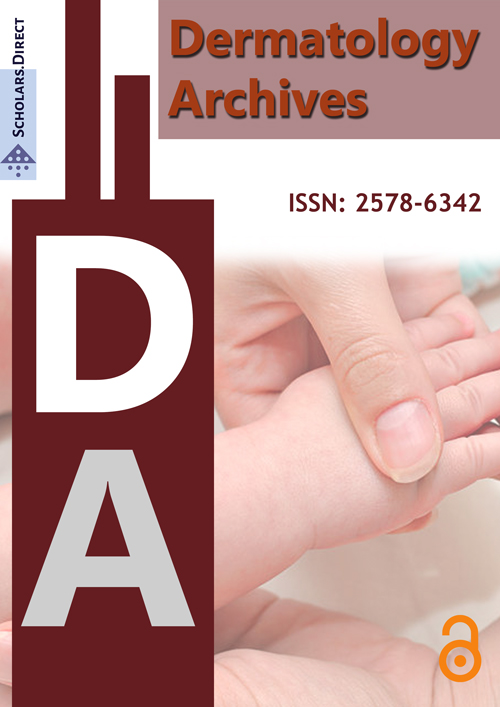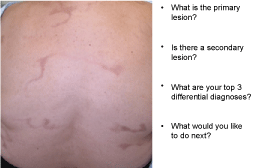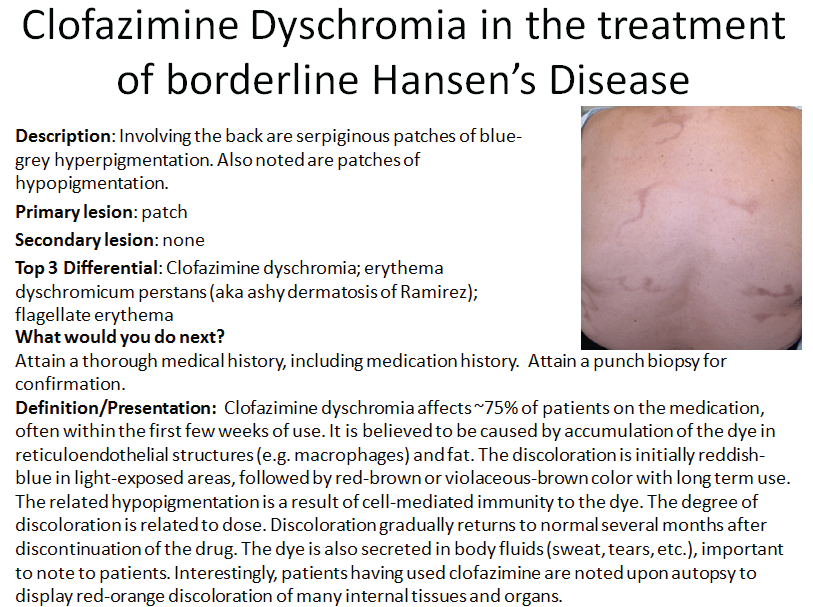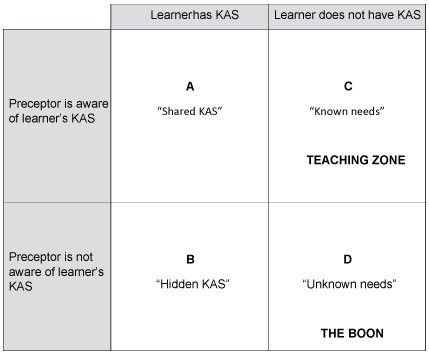Descriptives Module - The Power of the Student Educator
Abstract
Background
Dermatology education is faced with the challenge of developing curricula for learners who possess a wide range of learning styles, strengths, and life experiences. Utilization of the V.A.R.K (Visual, Aural, Reading/Writing, Kinesthetic) model of learning, outcome-based adult-learning theory, and inclusive participatory teaching offers a unique opportunity to teach dermatology.
Objective
To create a V.A.R.K. centered multi-modular experiential learning activity that encompasses the core values of V.A.R.K. in a learner-directed exercise.
Methods
For visual learning, kodachrome slides were provided to fourth year medical students participating in clinical clerkships students for independent review. Students who engaged in clinical reasoning were given opportunities to develop the answer slides for the review module, creating opportunities for tutorial-based read-write learning. The kodachromes were presented at the dermatology resident conference, where students presented their slides, enabling auditory learning. Kinesthetic learning was achieved through actively engaging in critical thinking, creating slides, and presenting the information.
Results
All students in subsequent elective blocks opted to participate, and seven of the ten students initially recruited continued to participate after the conclusion of their rotation. Additionally, residents requested this exercise as continuity lectures.
Conclusion
Learner-centered modalities can provide flexible and engaging opportunities for meaningful education in ways that appeal to diverse types of learners.
Preface to Descriptives
"The content of a curriculum is more often determined by faculty interests than by educational merit" - Executive Skills for Medical Faculty, 2nd edition [1].
In the traditional educational paradigm of teaching medicine by clinical faculty, this indeed may often be the case, but when the faculty's interest is the very educational foundation of the learner, learning itself becomes the focal point. Individuals summoned to walk the healing path are often compelled to want to make a difference in the lives of others. As an educator of medical students, residents, physician assistants and a wide range of nurses, with a passionate call to teach, I believe it is fundamentally important to build relationships based in mutual respect and direct mentoring based on the students' learning needs (learning centeredness).
To assess motivation and learning needs, the learner is asked to create three learning goals for themselves. The goal of the course block is to achieve these (together), and in doing so, confirm accomplishment. The goal question is open ended and answers have varied over the years ranging from learning the top 10 diagnoses in dermatology to better understanding the role of spirituality in healing. No matter what the student chooses, we commit to working together in their learning pursuit, and in doing so; I myself have fed my desire to learn.
Students are encouraged to attain knowledge regarding their own learning-style preferences, utilizing self-assessment tool such as Meyers-Brigs Type Indicator MBTI, Strength-Finder 2.0 and the V.A.R.K. questionnaire-guide to learning preferences. Similar to the Socratic Teaching Method, learners (students to colleagues) are nurtured to share goals and objectives, information and key assumptions. This measure encourages the learner's self-awareness and serves to remind me to refrain from transferring my own learning and teaching preferences onto the learner. Through engaging in teaching to the learners' preferences, I extend beyond my 'comfort zone' in my own knowledge, skills and aptitudes and I become the student. I am deeply aware that this mode encourages greater self-awareness in me and believes it has helped me to develop teaching mastery over time.
Whitman [1] discusses that medical teachers are most useful when what they teach is up-to-date and relevant to the learner. Furthermore, they are novel if "how they teach is interesting, memorable, and innovative". In the summer of 2015, health-care students interested in learning dermatology noted a need to learn to describe lesions, connect the description to the underlying pathophysiology of the disease and then be able to build a sound differential diagnosis and treatment plan. To meet this need, together, we designed the descriptives teaching tool. The tool was presented as an optional learning opportunity to the subsequent blocks of students who themselves continued to build it for the students to come, stating "it was useful and creative". We present the tool in the following article, as a possibility in instruction design and to demonstrate the power of the student to be the educator.
Introduction
With continued advances in technology and accessibility, medical knowledge has expanded exponentially. Adding to that the growing understanding of other crucial elements of health - emotional, social, spiritual, cultural - medical education becomes increasingly challenging. The final result is overwhelming, often compared to drinking from a fire-hydrant.
In dermatology education, programs strive to develop curricula that stimulate meaningful learning. The challenge in this lies in the vast knowledge base that must be attained, alongside inherent variations in learning preference styles and teacher aptitude. Literature on adult learners speaks to the fact that learners are not facsimiles with identical needs, and instead often focuses on relevance and outcomes.
Conceptually popularized by Malcolm Knowles, Andragogy is defined as the study of adult learning [2]. Rather than being defined by age, adult learning refers to the way that a learner absorbs and processes information [2]. Knowles makes five primary differentiations between adult and child learners. First, adult learners are self-directed and are not dependent on an authority figure. Second, whereas children absorb information passively in order to create a framework for understanding the world, adults are active learners. They filter information and add pertinent details into their existing framework to strengthen and bolster their knowledge with less focus on rote memorization and more on critical thinking skills. Third, readiness to learn becomes increasingly oriented towards a goal. Adults do not accept education for education's sake, and are more concerned with the value of their time and the efficiency of their education [3]. Fourth, this orientation is based on when knowledge is applied, and adults put increased weight on learning that has potential for immediate use. Finally, adult learners are internally motivated. Their retention of information is affected by emotion, self-worth, and sense of achievement.
While Knowles' work is based on a series of assumptions and principles about the adult learner, Kolb's theory of experiential learning, is often viewed as a cycle in which the learners' experience is the foundation of their development [4]. In this instance, the focus is on the process of learning as the learner progresses through each stage. The four stages within this model are: 1) Concrete experience- the learner actively experiences a new topic/situation; 2) Reflective observation- the learner observes and reflects about the experience; 3) Abstract conceptualization- the learner thinks critically about the experience to create and formulate analytical concepts and 4) Active experimentation- the learner tests the concepts and this serves to guide new and future experiences [4,5]. It is important to note that individuals not only vary in their knowledge base and experience, but also in how they process information, reflect and conceptualize. Much attention has been given to the modalities through which learning occurs. The V.A.R.K. model by Neill Fleming [6] evaluates learners by how they process Visually, Aurally, through Reading/writing, and Kinesthetically with the theory that understanding learners' preferred learning style(s) opens up the preceptor's window of teaching opportunity. Visual learners attain their information more readily through graphs, charts, flow sheets, and images. Readers/writers, on the other hand, interpret the same information better through the printed word, while aural learners learn best through hearing and conversation. Finally, kinesthetic learners attain "theory through its application" and utilize all of their senses [6]. By teaching across preferences, more students would be able to maximize their potential and increase efficiency in their learning process. Since learners are not restricted to a single modality, and, in fact, many learners are multi-modal, learner-centered teaching should attempt to incorporate all the modalities.
How do health-care providers learn dermatology?
Learners are typically taught through preceptored clinics, bedside rounds, didactic lectures, journal club, and grand rounds. Preceptored clinics provide a multimodal opportunity, as the learners are able to see, touch, and interact with patients. Direct education of the patient provides opportunity for the aural learners, which can then be enhanced further with diagrams and written instructions, for the visual and read-write learners, respectively. These clinics may be generalized or specialized. Specialized clinics may aid in pattern formation for specific disease processes, and generalized clinics offer opportunities to develop clinical reasoning skills. Bedside rounds allow observation, which is both visually and aurally stimulating for learners watching preceptors narrate exams and procedures. Didactic lectures and grand rounds strengthen the scientific foundation for integration with clinical experiences. Resident-led didactic lectures further aid in education via learning through multi-modal teaching. Regular evaluation of knowledge, such as quizzes before lectures, encourages self-motivated learning and appeals to those with read/write preferences.
Hypothesis
A V.A.R.K.-centered multi-modular experiential learning activity could be created to encompass each of the core values in one activity and be well received by adult learners in training. To accomplish this, an innovative curricular design module was created to encourage visual, auditory, read-write, and kinesthetic learning that builds upon the learners' experience via exposure to dermatologic lesions and their associated conditions. If there is continued interest in the modality from incoming learners, then the module would further develop, potentially becoming a resource to other learners.
The Descriptives Module
Students enrolling in the dermatology elective were given a 'handbook' outlining the "descriptors", or specific words utilized in dermatology to describe skin lesions (see Table 1 Primary lesions, and Table 2 Secondary lesions) to familiarize themselves with the vernacular. The Descriptives exercise was then created and administered in the following manner during each of the subsequent "modules".
Step 1
The teaching faculty member provided six kodachrome-based clinical images to the students, each with the same three associated questions (see Figure 1 is an example of a tested image slide). The students were invited to commit to answer the questions, and (to increase the fun-factor), were told that the first (or only) student to solve the case correctly would have the opportunity to put together and 'create' the answer slide, as well as to present it in an educational forum with the dermatology residents the following week (see Figure 2). Upon its creation, the answer slide was reviewed in detail with the attending. Volunteering to lead in the creation of an answer slide and formatting their presentation as a one-on-one mentored activity with the teacher allowed active learning in a supportive environment.
All students participated in answering the module and sent their answers to the teaching faculty member who was then able to gauge the knowledge base and deductive reasoning skills of the students in comparison to their peers (and in the forum to the post-graduate dermatology residents in training), as all students are given the same subject material (common denominator). The cases were deliberately challenging, giving students the opportunity to problem solve, and were aimed at the level of a graduating third year dermatology resident. There was a wide range in the type of answers the students gave, from broad, unrelated diagnoses to clustered diagnoses with similar mechanisms and pathophysiology or mimicking clinical presentation (see Table 3-Deductive reasoning).
Building on Whitman and Schwenk's adaptation of the "Johari Window" for preceptorship [7], the Descriptives learning module gave the preceptor an overview of each individual learner's Knowledge, Attitude, and Skill (KAS) set. In this way, insight was provided into the "Shared KAS", defined as knowledge the learner has which the preceptor is aware of (see Figure 3), and also allowed for assessment of each individual learner's areas of "Hidden KAS" and "Known Needs". The "Hidden KAS" is specifically the areas where the student had knowledge that the preceptor was unaware of, while the "Known Needs" was the area where instruction was needed (a.k.a. The Teaching Zone) because the students were all assessed on the same material, teaching could be individualized. Finally, this innovative learning tool provided the opportunity to discover "Unknown Needs," the area the Preceptor was unaware that the learner didn't have KAS. When educators are provided this opportunity, they can address the evidence for and against the student-proposed diagnoses and bring in up-to-date literature during the forum; in this way, educators themselves ultimately become students, assessing their own unknown learning needs. Since this is an educational opportunity for bidirectional learning, where both the preceptor and the student can be collaborative learners, this area was called 'The Boon'. [Figure 3 Modified Johari Window based on Whitman and Schwenk model of KAS (Knowledge, Attitudes, Skills) [7]].
The correct answers were revealed during the educational forum with the dermatology residents. In this forum the residents were presented with the same kodachrome-based clinical images and asked to describe the lesion (what do you 'see', and 'audibly' describe the lesion), give a differential diagnosis (providing an opportunity to engage in critical thinking and deductive reasoning skill development) and provide a plan. This is performed similarly to the traditional grand rounds structure, starting with first year dermatology resident, then progressing to the second and then the third year, wherein the faculty moderator interacts with each discussant-resident, again providing an opportunity to assess learning needs and instruct. Ultimately, this also provides the students the opportunity to learn from the residents. The student then presents the answer, giving the residents the opportunity to learn from the student, and bidirectional learning is achieved.
The strength in this learning exercise is the inherent opportunity to utilize each of the V.A.R.K. learning styles throughout the streamlined process. Visual learning is addressed with the kodachrome-based image, read-write through the wording on the slides (both in its preparation and presentation), auditory in presenting the case aloud, and kinesthetic through actively engaging in critical thinking and creating the slide and performing the presentation.
Step 2
In the same style as was led by the teacher, the students are each instructed to create a kodachrome-based 'question slide' with the same 3 clinical and descriptive questions, and also complete the associated 'answer slide'. The students then were given the opportunity to receive both feedback and instruction in regards to the case concept, photo, and answer slide with the preceptor. In step 1, students were prompted to voluntarily 'compete' for the opportunity to be the teacher by being the first to correctly deduce the case, in step 2, every student is encouraged to participate at their own pace with a fortnight deadline in creating a slide to present in the subsequent forum with the dermatology residents, utilizing the student-made question slides. Again, the structure is to progress through the training levels of the residents (starting with the junior residents), all learning the correct diagnosis through collaborative deductive reasoning. Finally, the students (who had time to look up and read about the cases, unlike the residents who are seeing the cases de novo) are given the opportunity to weigh in and participate, if the correct diagnosis is not rendered.
Results
Participation and retention were high with 6 participants in month 1, 9 in month two, 13 in month three, and 14 in month four. At the end of month three, 24 students were actively participating, with 11/15 (73%) of students from previous rotations continuing to participate after their course had ended. Furthermore, the residents have requested this to be a bimonthly learning activity. This continuity in learning was reflected by improvement in performance. In the first quarter, only 20% of learners accurately described a lesion. By the second quarter, this increased to 65%.
At the end of 6 months, there were 50 cases in the module, built by and with the students and faculty in partnership. Eleven questions were not successfully answered. In these cases, the person chosen to present was the student who came closest to the correct category or noticed an important subtlety significant to the answer. Of the 39 answered questions, 31 (62%) were answered correctly by only 1 person, 6 (12%) by 2 people, and 2 (4%) by 3 or more (see Table 4). No one got all 50 correct. "Three" selected quotations from learners describing positive learning experiences are provided to illustrate the feedback received regarding the new educational activity. It is important to note that these same students were rotating from and at other institutions that did not have this activity, so their feedback included an internal comparison of their other clerkship experiences. Three quotes from learners: I enjoy doing the modules. They have enhanced my understanding of dermatology greatly. I appreciate your efforts in seeking out a variety of interesting cases and facts to help us retain the information. "I loved the descriptive learning cases and opportunities to simply discuss". "I enjoyed this exercise very much; it complemented what I have learned in my practitioner preceptorship".
Discussion
In the Descriptives, all learners were asked the same question and provided the same opportunity to apply and explain their deductive reasoning skills. This allowed for comparative analysis of learner's knowledge base and allowed for identification of outliers (i.e. unexpected knowledge). It also aided in developing the metric for the subsequent quarter and year, allowing educators to rate students across their peer group and previous months/years in training.
While adult learning theory has been helpful in the design of medical curricula, interest in medical education is not new. In 1910, Abraham Flexner published Medical Education of the United States and Canada: A Report to the Carnegie Foundation for the Advancement of Teaching. This report changed the approach to medical education, recognizing the need for higher standards, more rigorous admission requirements, and standardization of curricula [8,9]. Now, 100 years later, the quest to improve medical education continues. Dale Irby, sponsored by the Carnegie Foundation for the Advancement of Teaching, laid out four principles to guide evolving medical education: standardization of competency and individualization of curriculum, integration of didactics and clinical experience, habituation of curiosity and self-improvement, and identity formation through self-awareness [9]. Irby's call to standardize competency while individualizing curriculum acknowledges that adults come into their education with broad experiences. If the end goal is a destination and students are starting in different places based on their unique experiences, then the best routes will differ from person to person. Therefore, a teacher's role is ultimately to set the destination, and help students on their individual journeys. The integration of formal knowledge with clinical experience enables learners to develop "pattern formation" [8,9]. Habituating curiosity and self-improvement empowers and encourages learners to take control of their education. This skill-set will serve them throughout their careers by making them life-long learners [2,9]. Lastly is the culmination of the educational process: the development and maturing of a student into an educator.
This represents a lofty challenge for educators. They are charged with producing competent health care providers with sound medical knowledge, critical thinking skills, adaptability to change, and creativity for innovation. In order to do so, they are expected to individualize learning plans, build self-confidence, and encourage self-awareness. In line with the Socratic Method, educators and learners can engage in dialogue [10]. Through question and answer conversations, educators can draw knowledge from learners and fill gaps, and in doing so become greater learners themselves. This serves to encourage self-awareness, build confidence, improve communication skills in learners, and develop teaching skill in the preceptor. Creating a positive environment and mutual respect fosters desire to learn and aids in the transition from student to preceptor and from preceptor to student.
The primary objective was to create an activity that would stimulate self-learning beyond the end of the student's rotation. Two years later the first students are still engaged with the department and requesting to participate in this activity. This study was limited by the number of participants. The fourth year clinical dermatology clerkship elective is based on the Socratian construct, thus a maximum of four students are permitted per block to ensure maximal interaction with the faculty. While this project was completed in a structured academic setting, this methodology can be adapted into a variety of settings. In addition to its versatility in setting, its greatest strength lays not only its ability to include learners of all levels and goals, but in the fact that it is strengthened by this increased diversity. In the world of teaching, innovative learner-centered modalities are the oysters in which pearls, such as the Descriptives module, can be nurtured to fruition.
References
- Whitman N, Weiss E, Bishop EM, Executive skills for medical faculty. (2nd edn), University of Utah, 99.
- Mahan JD, Stein DS (2014) Teaching adults-best practices that leverage the emerging understanding of neurobiology of learning. Curr Probl Pediatr Adolesc Health Care 44: 141-149.
- PBS Teacher Line (2007) Characteristics of adult learners.
- Kolb D (1984) Learning from experience.
- Leung F, Martin D, Batty H (2009) A theory-based curriculum design for remediation of residents' communications skills. Med Teach 31: e555-e559.
- Fleming N (1995) I'm different; not dumb. Modes of presentation (VARK) in the tertiary classroom. In: Zelmer A, Research and development in higher education, proceedings of the 1995 Annual Conference of the Higher Education and Research Development Society of Australia (HERDSA). HERDSA, 18: 308-313.
- Whitman N, Schwenk TL (1984) In preceptors as teachers: A clinical guide to teaching. Creative Education, Salt Lake City, UT, 4.
- Irby DM (2014) Excellence in clinical teaching: Knowledge transformation and development required. Med Educ 48: 776-784.
- http://infed.org/mobi/malcolm-knowles-informal-adult-education-self-direction-and-andragogy/.
- Ross V (2003) The Socratic method: What it is and how to use it in the classroom. Speaking of teaching, Stanford University newsletter on teaching, 13.
Corresponding Author
Sharon E Jacob, Professor, Department of Dermatology, Loma Linda University, 11370 Anderson Street, Suite 2600, Loma Linda, CA 92354, USA, Tel: 909-558-2890, Fax: 909-558-2448.
Copyright
© 2017 McGowan M, et al. This is an open-access article distributed under the terms of the Creative Commons Attribution License, which permits unrestricted use, distribution, and reproduction in any medium, provided the original author and source are credited.







